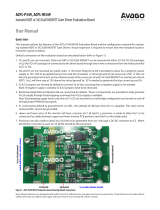Page is loading ...

Broadcom Ltd.
- 1 -
Introduction
Silicon Carbide (SiC) power semiconductors are rapidly
emerging into the commercial market, delivering several
benefits over conventional Silicon-based power
semiconductors. SiC MOSFETs can improve overall system
efficiency significantly, and the higher switching capability can
reduce the overall system size and costs. The technical benefits
coupled with lower costs have increased the fast adoption of
SiC power semiconductors in applications like industrial motor
control, induction heating, industrial power supplies, and
renewable energy.
Broadcom optocouplers, which are used extensively with
Silicon-based semiconductors like IPM, IGBT and Power
MOSFETs, can also be used for SiC operations. Optocouplers are
used to provide reinforced galvanic insulation between the
control circuits from the high voltages and the power
semiconductors. The ability to reject high common mode noise
(CMR) will prevent erroneous driving of the SiC power
semiconductors during high frequency switching.
This reference design will describe the basic operation of using
IPM Interface optcoupler ACPL-4800 for the Wolfspeed (CREE)
SiC MOSFET isolated Gate Driver. Detailed operations, board
configurations, schematic, and BOM can be found in Wolfspeed
(Cree) SiC MOSFET Isolated Gate Driver Application Note.
Figure 1 shows the top and bottom views of the enhanced gate
driver. The enhanced creep distance is accomplished with the
groove in the printed circuit card.
Gate Driver Board Features and
Operations
The schematic for the gate driver is shown in Figure 2. The
circuit consists of a Broadcom optocoupler (U1), two isolated
DC-DC converters (X2 and X3), and a current buffer (U2).
The Broadcom ACPL-4800 has high common mode transient
immunity (30kV/μs min.) and can operate from 4.5 V to 20 V. It
can provide isolation certified by UL1577 for up to VISO
3750 VRMS/min and IEC 60747-5-5 for working voltage, VIORM
up to 630 VPEAK. A +10 V to +12 V pulse is applied to the input
LED of the ACPL-4800 via split resistors network R3 and R6 to
control the gate driver's output. The ACPL-4800 fast-speed
optocoupler contains a GaAsP LED and photo detector with
built-in Schmitt trigger to provide logic-compatible
waveforms, eliminating the need for additional wave shaping.
The totem pole output eliminates the need for a pull-up
resistor and allows for direct drive of the current buffer.
Power is provided by isolated DC-DC converters; one for the
positive bias and the other for negative bias. X2 and X3 are
both from the Recom RP series of 1 watt unregulated isolated
DC-DC converters. As shown in the schematic, the outputs of
the converters are series connected and the common
connection is referenced to the source terminal. Therefore, VCC
determines the gate pulse positive voltage and –VEE
determines the negative gate pulse voltage. The –VEE node is
used as the ground reference for the ACPL-4800 and the
current buffer. An emitter follower consisting of Q1 and D1 has
been added to limit ACPL-4800's VCC below 20 V operation.
The current buffer, the Clare/IXYS IXDN609SI, can provide 35 V
output swing and up to 9 A of current with a typical output
resistance of 0.8 Ω. Gate resistors, R2, R4, R5, R9–R15, and diode
D2 can be populated to provide optimum turn-on and turn-off
performance. To minimize stray inductance, capacitors C8–C10
are located very close to the source output pin and the gate
driver to provide very tight coupling between the source
output terminal and the –VEE node.
ACPL-4800
Wolfspeed(CREE) SiC MOSFET Gate Driver
Reference Manual

Broadcom Ltd.
- 2 -
ACPL-4800
Reference Manual
Gate Driver Board Features and Operations
Figure 1 SiC MOSFET Isolated Gate Driver
Figure 2 Schematic of the Gate Driver Board

For product information and a complete list of distributors, please go to our web
site: www.broadcom.com
Broadcom, the pulse logo, Connecting everything, the Connecting everything
logo, and Avago Technologies are among the trademarks of Broadcom Ltd.
and/or its affiliates in the United States, certain other countries and/or the EU.
Any other trademarks or trade names mentioned are the property of their
respective owners.
Broadcom Ltd. reserves the right to make changes without further notice to any
products or data herein to improve reliability, function, or design.
Information furnished by Broadcom Ltd. is believed to be accurate and reliable.
However, Broadcom Ltd. does not assume any liability arising out of the
application or use of this information, nor the application or use of any product
or circuit described herein, neither does it convey any license under its patent
rights nor the rights of others.
Copyright © 2016 Broadcom Ltd. All Rights Reserved.
pub-005532 – February 29, 2016
/
